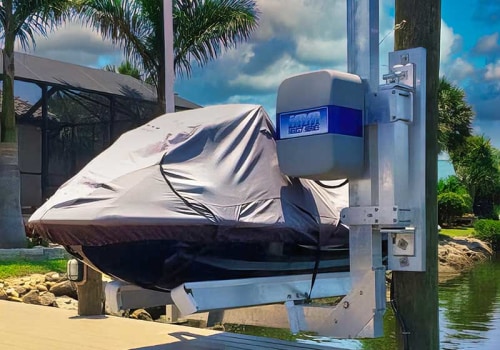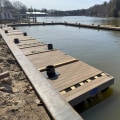Welcome to our comprehensive guide on aluminum docks! If you're in the market for a new dock, or just looking to learn more about different types of dock materials, you've come to the right place. Aluminum docks have become increasingly popular in recent years due to their durability, versatility, and low maintenance requirements. In this article, we will dive into all the details you need to know about Dock Construction near Hanahan SC and the use of aluminum docks, from their construction and installation process to the benefits and drawbacks of using this material. Whether you're a homeowner, business owner, or just curious about docks, this article will provide valuable insights and information for you.
So, let's get started and explore the world of aluminum docks!When it comes to building a dock, aluminum is a top choice for many boat owners. Not only is it a durable and long-lasting material, but it also offers a sleek and modern design. If you're considering an aluminum dock for your waterfront property, there are a few things you should know before beginning the construction process. Firstly, let's discuss the different types of aluminum docks available on the market. There are two main types - stationary and floating.
Stationary docks are permanently attached to the shoreline, while floating docks are free-standing and can move with the water. Depending on your specific needs and location, one type may be more suitable than the other. Once you've decided on the type of aluminum dock you need, it's time to choose the right materials. The most common materials used for building aluminum docks include aluminum frames, decking, and hardware. You can purchase these materials from your local hardware store or online retailers.
It's important to consider the cost of materials and choose high-quality products that will withstand the elements. The construction process for aluminum docks is relatively straightforward, but it's important to follow the proper steps for a sturdy and safe dock. First, you'll need to prepare the shoreline by leveling the ground and adding support posts. Then, you'll assemble the frame using your chosen materials and secure it to the support posts. Next, you'll add the decking and any additional features such as ladders or benches.
It's crucial to follow manufacturer instructions and consult with a professional if needed. After your aluminum dock is constructed, it's time for installation. This process will vary depending on the type of dock you've chosen, but some general tips include ensuring proper alignment, using sturdy hardware, and anchoring the dock securely. It's also important to consider any local regulations or permits that may be required for dock installation. To keep your aluminum dock in top condition, regular maintenance is necessary. This includes cleaning the surface and checking for any damages or loose hardware.
You may also need to repaint or replace decking boards over time. It's important to address any issues promptly to prevent further damage and ensure the safety of your dock. Lastly, let's discuss design ideas for floating aluminum docks. These types of docks offer versatility in terms of design and can be customized to fit your personal style and needs. You can add features such as built-in seating, storage, or even a roof for shade.
If you're not sure where to start, there are many services available that specialize in custom dock designs.
Materials Needed for Construction
To build an aluminum dock, you will need the following materials: aluminum frames, decking material (such as wood or composite), support posts, bolts and screws, and various tools (such as a drill, saw, and level). The cost of these materials will vary depending on the size and design of your dock.Maintenance and Repair
Despite their reputation for being low maintenance, aluminum docks do require some upkeep to ensure they stay in top condition. In this section, we will cover the important tasks that need to be done to maintain your aluminum dock, as well as how to properly repair any damage that may occur.Design Ideas and Services
Aluminum docks are known for their sleek and modern look, making them a top choice among boat owners. Their clean lines and minimalist design add a touch of elegance to any waterfront property.But beyond their aesthetic appeal, aluminum docks also offer practical benefits such as durability and low maintenance. If you're considering building an aluminum dock, you might be wondering about the design options available. One popular design idea is a floating aluminum dock. This type of dock is anchored to the shore but has floating sections that move with the water's fluctuations. It provides a stable platform for docking your boat while also allowing for easy access to the water. But the options don't stop there.
Aluminum docks can also be customized to fit your specific needs and preferences. From different sizes and shapes to add-ons like benches or ladders, the possibilities for customization are endless. If you're not sure where to start with designing your aluminum dock, there are services available that can help. Many dock construction companies offer design consultations where they can work with you to create a custom dock that fits your vision and budget. They can also provide 3D renderings so you can see exactly what your dock will look like before it's built.
Types of Aluminum Docks
When it comes to building a dock, one of the most important decisions is choosing the right material.And for many boat owners, aluminum is the top choice. Not only is aluminum durable and low maintenance, but it also offers a sleek design that can enhance the overall look of your dock. However, within the category of aluminum docks, there are three main types: stationary, floating, and roll-in.
Stationary aluminum docks
are attached to the shoreline and do not move with the water level. These docks are typically more stable and sturdy, making them a great option for areas with rough water or high winds.They are also ideal for permanent installations.
Floating aluminum docks
, on the other hand, are not attached to the shoreline and move with the water level. This type of dock is better suited for calm waters and areas with minimal fluctuation in water levels. They are also easier to install and remove. Lastly, we have roll-in aluminum docks, which are a combination of stationary and floating docks. These docks are attached to the shoreline but have wheels that allow them to be rolled in and out of the water.They offer the stability of a stationary dock with the convenience of a floating dock. When deciding on the type of aluminum dock to build, it's important to consider your specific needs and preferences. Factors such as location, water conditions, and budget should all be taken into account before making a decision. But no matter which type you choose, you can be sure that an aluminum dock will provide you with a durable and long-lasting solution for your boating needs.
Installation Process
The installation process for aluminum docks may seem intimidating, but with the right tools and instructions, it can be a straightforward process. Aluminum docks are typically lightweight and easy to assemble, making them a popular choice for DIY projects.However, it's still important to follow the proper steps to ensure a safe and secure installation. Before beginning the installation process, make sure you have all the necessary tools and materials. These may include a drill, screws, anchors, and a level. It's also important to have a helper or two to assist with lifting and positioning the dock. The first step is to carefully plan out the placement of your dock. Consider factors such as water depth, shoreline configuration, and any potential obstacles in the water.
It's also important to check with local regulations to ensure you are following any necessary guidelines. Next, start by assembling the frame of the dock on land. This will make it easier to transport and position in the water. Once the frame is assembled, carefully move it into the water and secure it using anchors or weights. Once the frame is in place, it's time to attach the decking panels. This may involve cutting the panels to fit around poles or other obstacles.
Make sure to use stainless steel screws for a secure and durable hold. Finally, make any necessary adjustments and add any accessories such as ladders or bumpers. It's also important to regularly inspect and maintain your aluminum dock to ensure its longevity. In conclusion, aluminum docks are an excellent option for boat owners looking for a durable, low maintenance, and visually appealing dock. By following the steps outlined in this article, you will have all the information you need to successfully construct, install, maintain, and even customize your own aluminum dock. Whether you're a DIY enthusiast or looking for professional services, aluminum docks are a great choice for any waterfront property.






